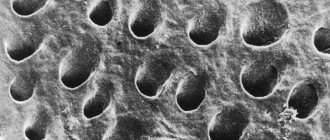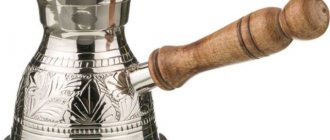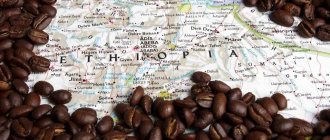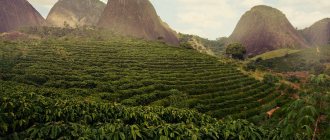Fashionable drink
Matcha is green tea, but has a different taste from loose leaf tea. The drink is rich in herbaceous aftertaste, freshness and light viscousness. It can be drunk both cold and hot. The bright unusual pistachio color gives the drink chlorophyll, which it contains in large quantities.
“Matcha latte” is a green drink with thick foam. Milk softens the taste. You can cook with any milk - soy milk, almond milk, coconut milk, rice milk. You can add cinnamon, cloves, vanilla or cardamom. You can drink it at any time of the day.
Tea
What are the benefits of black tea?
Black tea is a highly oxidized tea made from fermented tea leaves. It contains 14-61 mg of caffeine per cup.
– protects the lungs when smoking cigarettes
- reduces the risk of stroke
– reduces the risk of coronary heart disease
– fights dangerous bacteria, strengthens the immune system
- speeds up metabolism
- fights free radicals that cause aging
Coffee
What types of coffee are there?
Coffee also comes in a huge variety of varieties. The most common ones include:
- "Arabica", which grows above sea level at an altitude of 900 to 2000 m. The grains of this variety are oblong in shape, with a smooth surface, slightly curved. During light roasting of beans, particles of coffee berries do not burn out completely.
- Robusta, which contains more caffeine, is considered less refined in terms of aroma.
According to various estimates, these two types account for up to 98% of all coffee produced in the world: Arabica makes up 70% of the volume, Robusta - 28%. The remaining varieties, which are not of industrial importance, account for 2% of the world's volume.
How to brew tea
The best recipes for tea and coffee cocktails
Of course, amateur experiments are interesting, but there are many popular recipes for such mixtures.
Be sure to read: Baileys coffee - exquisite “Irish” taste and unique aroma
Chai Eggnog Latte from Starbucks (or Eggnog Latte)
In European coffee shops of the Starbucks chain in winter they serve the following cocktail:
- 200 milliliters of tea with spices;
- a cup of espresso;
- egg yolk, beaten with sugar;
- a pinch of nutmeg.
Beat the yolk together with sugar until it forms a strong foam. The tea is brewed with the addition of cardamom, cinnamon, cloves and star anise. Mix with espresso and top with egg foam sprinkled with nutmeg.
With the addition of lemon and honey
A popular remedy for colds and flu consists of:
- a cup of brewed tea;
- a portion of coffee;
- one tablespoon of honey;
- slice of lemon.
First, mix tea with any coffee and wait until the mixture reaches a temperature at which you can drink it without fear of getting burned. And only after that they put honey in it so that it does not lose its medicinal properties due to thermal effects. After thoroughly stirring the honey, add a slice of lemon or its juice.
Yuanyang from Hong Kong
That very drink personifies the ideal union of two principles. It can be made either according to the classic recipe or simplified a little.
- any black tea (it’s better to take loose tea, but bagged tea will do);
- a portion of coffee;
- milk and condensed milk.
More tea is added to this cocktail than coffee - the proportions are usually approximately 60 to 40 or 70 to 30. The tea is boiled in boiling water for about 5 minutes, then condensed milk is added to it to taste and left on low heat for another couple of minutes. Add milk and prepared coffee.
Tea Recipes
Interesting coffee and tea recipes
Our experiments turned out to be interesting, but what about slightly more complex and “professional” combinations? We have found different ways for you to prepare this mix:
Eggnog Latte (Chai Eggnog Latte) from Starbucks
During the winter months, this drink can be found on the menu of some European Starbucks.
- Tea – about 200 ml;
- Espresso;
- Beaten egg yolk with sugar;
- Nutmeg.
Beat the yolk with sugar into a thick foam. Brew tea, preferably with spices - cloves, cinnamon, star anise, cardamom are suitable. Add a shot of espresso and top with egg foam and sprinkle with nutmeg. A spoonful of rum or brandy would be appropriate.
With honey and lemon
An anti-cold remedy when you also need to stay alert (ideal for those who can’t tear themselves away from work or school).
- A cup of tea;
- Espresso;
- A tablespoon of honey;
- Lemon.
Brew tea, add espresso or just a little strong coffee. We wait until the liquid cools down to a warm state, when you can already drink in normal sips, then add and stir the honey. In too hot water, honey loses its beneficial properties, and now we need not only taste, but also benefits. And add lemon, you can squeeze it into a quarter.
Hong Kong Yuanyang
The whole of Hong Kong drinks it, so why not try it? Moreover, everything is very simple. You can follow the classic recipe or simplify it for quick preparation.
- Black tea, preferably loose leaf, but also in bags;
- Brewed coffee or espresso;
- Condensed milk + regular milk.
The proportions are approximately 60x40 or 70x30, with more tea. You may not measure absolutely accurately. Boil a teaspoon of tea leaves in water for 5 minutes; if you have tea leaves, tear off the tag with the string and boil like that. Add a tablespoon of condensed milk and cook for another 2 minutes over low heat. Mix with coffee and milk.
Tea varieties
Bubble tea
It is popularly called Boba tea. Also popular is the name bubble and pearl tea. Black or green tea is suitable. There are dozens of flavors. Tea is infused with syrups, cream, plants, or fruit extracts. All ingredients are whipped and mixed together.
This special tea originates from Taiwan. The first experiments were carried out in the 1980s. At first, the number of ingredients was limited, as were coffee and tea. It was regular tea mixed with fruit syrup. Later, it became popular to add tapioca balls filled with juice. The drink turned out beautiful and tasty.
Worldwide distribution occurred later when the tea found its way into the Japanese media. The main countries that have tasted Taiwanese tea are the USA, Australia and China. Among the European countries, England and Germany stand out. Russians also love to drink the drink in cafes. You can try it in almost all major cities.
More: Instant coffee Armel and reishi mushroom to strengthen the immune system
History of tea
The history of tea goes back thousands of years, so it is not surprising that the origin of tea is shrouded in the most incredible legends. Therefore, today it is difficult to say exactly how tea entered human life, but the generally recognized birthplace of tea is China. Already at the beginning of this millennium, tea was grown in China for sale, and there was a culture of consumption of this drink.
China carefully guarded the secret of tea creation for many centuries, but gradually tea began to spread in the East, and then in the West.
Tea in our country has its own special history. Long-standing ties between Russians and Chinese ensured that Russian residents became familiar with this drink quite early. Officially, tea began to spread in Russia in the 17th century. Towards the end of the 19th century, tea was able to acclimatize in Georgia. Krasnodar tea, grown directly in Russia, dates back to 1936.
Tea: about the diversity of types
There are several main types of tea, differing both in their taste and aroma, and in their unique effects on the human body:
- Green. Has a weak oxidation state. Has a pronounced herbal aroma. The taste can be slightly tart or sweet. Valued as a natural antioxidant. It contains: carotenoids, polyphenols, vitamin C, minerals (zinc, manganese, selenium).
- Black. A strongly brewed drink normalizes digestion, is effectively used to treat typhoid fever, dysentery, and removes harmful substances from the body.
- White. It is made from unopened buds and young tea leaves. Not subject to heat treatment. It is distinguished by a light or yellowish color of the dry mixture. Known as the tea of health and youth. Strengthens the immune system, heals wounds, increases blood clotting, and prevents the occurrence of various diseases.
- Yellow. Elite tea made from young buds. There is a slight bitterness in the taste. Increases immunity, relieves headaches.
- Oolong. Close to black tea. It has a bright, rich aroma with notes of chocolate, honey, flowers, fruits, and spices. Contains essential oils, vitamins and beneficial minerals. Positively affects human health.
- Puer. Lowers blood sugar, improves the functioning of the digestive tract, removes toxins, rejuvenates and tones the skin.
Tea production
After picking, tea leaves undergo complex processing. The type of tea mainly depends on the processing method. First, the tea leaves are carefully sorted, low-quality specimens are rejected, and the top leaves are selected for elite varieties. Then the withering process takes place, aimed at removing moisture from the tea leaves. Withering can be either natural or artificial - carried out in the sun or indoors. To produce black or red teas, tea leaves are fermented.
To free the leaves from tea juice, twist them. This process can also be mechanized or done manually.
Only after this the tea leaves are dried. Drying takes place in special containers with high temperature and air supply. It is very important to cool the tea leaves properly at this stage. After these numerous manipulations, the tea is sorted and packaged.
What are the benefits of green tea?
Green tea is a slightly oxidized tea that has a more subtle flavor than black tea. The tea leaves are dried and heated after picking, which stops the fermentation process. Contains 25 - 40 mg of caffeine per cup.
– reduces bladder cancer, breast cancer, lung cancer, stomach cancer, pancreatic cancer and intestinal cancer
– prevents the formation of blood clots that lead to heart attack and stroke
- burns fat
– reduces the risk of neurological diseases such as Alzheimer's disease and Parkinson's disease
- regulates cholesterol levels
– strengthens teeth and bones, reducing the risk of osteoporosis and caries
History of coffee
The history of coffee beans also goes back centuries, in no way inferior to tea. It is known that wild coffee comes from Ethiopia, where it is still found growing wild, but the magical drink was cultivated in Yemen. Yemen had a monopoly in coffee exports until the 17th century. It is here that the port of Mocha is located, which gives its name to the popular variety of coffee. Beginning in the 17th century, Europeans learned to grow coffee, bringing it to their southern colonies. As a result, coffee spread to Australia, Asia and South America, and in Brazil, for example, it took root so much that it became one of its symbols.
Brazil is one of the world's major coffee nations, holding more than 30 percent of the coffee market. Yemeni coffee beans were introduced here in the 18th century. Nowadays, various varieties of this elegant drink are produced here, mostly Arabica, most of them in a low price category. Robusta is also grown here, approximately 15% of the total production.
Coffee was also brought to Colombia in the 18th century, and from the 30s of the 19th century the country began to export coffee. Here coffee is one of the main crops, producing 15 percent of the world's coffee. The quality of Colombian coffee is recognized throughout the world due to its location and climate.
Coffee is also grown in Costa Rica, where there are also excellent conditions for the growth of coffee trees - rich soil, tropical humid climate. Costa Rica began exporting coffee in bulk before other Latin American countries. And today, the sale of coffee is one of the mainstays of the country’s exports. Some of the best coffee in the world is produced here.
Mexico ranks 4th in the world among coffee suppliers; Arabica beans are produced here, while the production of coffee for wholesale sale is mainly carried out by private farmers.
Coffee was brought to Kenya at the very end of the 19th century by the British. There are high mountain plantations here and two harvests are harvested annually.
In Indonesia, coffee, introduced by the Dutch, has been grown for wholesale sales since 1712. During this time, Indonesia managed to become the third country in the world in coffee production. Robusta is mainly grown here.
Coffee composition
About a quarter of raw coffee beans consists of caffeine, trigonelline, chlorogenic acid, protein, and mineral salts. The rest is fiber, oil, water. The main component, the effect of which on humans is ambiguous, is caffeine. This is a representative of the alkaloid group of the purine series. It is its presence in coffee that gives vigor. In its pure form, it appears as colorless crystals, but has a bitter taste.
Doctors and physiologists conducted a huge number of experiments to find out the effect of this substance on humans. It is an established fact that small amounts of caffeine activate the nervous system. This improves the metabolic processes of blood circulation and stimulates the work of all important systems. It is widely used in the pharmaceutical industry. It should be noted that during brewing, almost all of the caffeine from the grain goes into the drink.
Each type of coffee has its own percentage of caffeine. According to this indicator, Robusta from Guinea is in the lead (from 1.7% to 2.3%), leaving behind Santos (from 1.3% to 1.5%) and Hodeidah (about 1.2%).
Another alkaloid in coffee beans that affects taste and aroma properties is trigonelline.
Roasting green beans removes water. Of the 11%, 3% moisture remains. At the same time, the process of caramelization occurs (the result is caramelin, which is responsible for the brown color of the drink). And the substance kafeol is responsible for the specific aroma. Roasted grains contain about 1.5% of this complex substance.
In the process of trigonelline destruction during roasting of grains, nicotinic acid (belonging to B vitamins) is released. And they are important for preventing a number of serious diseases, including pellagra. For example, residents of a number of regions of South America almost do not suffer from pellagra (although the population there is very hungry). The secret of this phenomenon is seen in drinking coffee.
In addition, coffee beans contain organic acids such as malic, citric, acetic, caffeic and others (more than thirty in total). The grains include high levels of chlorogenic acid (4-8%). Its decomposition during roasting of beans gives the drink an astringent flavor. It has been proven that acids in certain doses are beneficial for the stomach and digestion.
Tannins are responsible for the characteristic bitterness of coffee. By adding milk or cream, we partially disarm these complex substances and soften the taste.
Back to Contents
Coffee production
Coffee production is a rather complex process. Harvesting is done either manually or mechanically (for inexpensive coffee varieties). After harvesting, the grains are processed.
Dry coffee naturally. Sometimes it is processed in a special machine and washed - this is a labor-intensive method and coffee of this level is quite expensive. The beans are then cleaned and sorted by size.
After this, roasting is carried out - one of the main stages of coffee bean production. It is most often fried in special frying machines. There are also roasting methods using gamma rays or microwaves. Then the beans are cooled, metal impurities are removed using machines, stones are removed and the coffee is ready for packaging.
The Russian tea company has unchanging traditions of quality. We offer tea and coffee connoisseurs only the best from the leaders of the tea and coffee industry - high-quality teas and coffee in bulk, and numerous related products. We know everything about tea and coffee.
Working with us, you choose the best!
Chemical composition of tea and coffee
When comparing the chemical composition of tea and coffee, it is best to start with alkaloids. It's mostly caffeine, but in tea it's called theine. There is more of it in tea than in coffee, but it has a lighter effect. This is due to the fact that the concentration of theine is lower than that of caffeine. And when brewing tea, the tea leaves are taken in smaller quantities than for coffee.
In addition to theine, tea contains theobromine, theophylline, adenine and guanine. Also, it contains more than 20 essential oils that determine its aroma. But they can quickly disappear if the tea is heated. 15-20% of tea consists of tannins. Due to tannins, the drink acquires its tart, slightly astringent taste and dark color.
We must not forget that tea contains almost all possible vitamins: C, B1, B2, PP, pantothenic acid and many others. Amino acids, various pigments, glucosides and carbohydrates are also present in this drink.
Coffee is also not deprived of useful substances. In addition to caffeine, it contains methyl betaine nicotinic acid, chlorogenic acid, various mineral salts, fiber, coffee oil and much more. Coffee is endowed with aromatic substances, of which there are more than 70, but they oxidize after contact with oxygen.
Both coffee and tea have a rich composition. The components of both drinks can help the body function, the main thing is to know when to stop and not drink too much.
What are the benefits of coffee?
Coffee, if consumed in small and reasonable doses, also has positive effects on the human body. It is important to remember that the coffee must be natural. Coffee lovers should not forget that the instant drink does not contain natural caffeine, it is replaced by a chemical analogue of the substance. While natural bean coffee contains it. This drink, according to experts, is useful for people suffering from migraines, headaches, and vascular spasms.
The caffeine in the drink gives the body vigor and the necessary energy. Those who like to drink a cup of coffee in the morning should remember the benefits this drink brings to their health:
- Coffee helps fight skin problems and signs of aging.
- Helps reduce weight.
- It has a beneficial effect on memory and increases concentration.
- Prevents the development of asthma and allergies.
- Strengthens hair.
- Fights the risk of developing cancer. It is known that coffee lovers are significantly less likely to suffer from liver and colon cancer. While the effect of anti-cancer tea has not yet been sufficiently studied by scientists.
- Helps eliminate the appearance of cellulite.
- In addition, coffee has a beneficial effect on the brain: it successfully prevents Parkinson's disease.
- The risk of diabetes is significantly reduced in those who drink up to 4 cups of coffee per day. No such qualities were found in tea.
- Drinking coffee successfully prevents the formation of gallstones.
What's best to drink in the morning?
Drinks containing caffeine are known to help wake up in the morning. Many people ask the question: what is healthier in the morning - tea or coffee? Experts believe that in terms of caffeine content, it is undoubtedly coffee. After all, caffeine in it: 380-650 mg/l, while in tea: 180-420 mg/l. As for tea, it has been proven that it is more capable of improving concentration than coffee.
A high caffeine content does not guarantee that the drink will effectively function as an alarm clock, scientists believe. Here the characteristics of the organism play an important role. Coffee and tea can equally give you energy in the morning. When choosing a morning drink, you should consider your health and personal preferences.
Is flower-herbal “tea” a tea?
True tea is only an infusion of the Camellia sinensis plant. There are black, green, white and oolong tea (Chinese semi-fermented tea) and all its types are obtained from this plant. Those varieties of “tea” that are obtained from flowers, herbs and even tree bark should be classified as herbal infusions.
Thus, calling herbal infusions tea is not entirely correct. Although, let’s face it, in stores you can often find boxes with inscriptions that literally prove that there is tea inside. From flowers, herbs and tree bark. Perhaps this is done only to attract the attention of buyers.
Does tea spoil?
Tea can lie on the shelf for up to six months. After this, it begins to lose antioxidants. In 2009, the Journal of Food Science, dedicated to nutrition science, published the results of a study in which scientists found that the content of catechins decreases markedly over time. After six months, their levels dropped by 32%. To preserve the antioxidants in your tea for as long as possible, the tea leaves should be stored in a sealed container in a dark, cool place.
Tired of tea already? Then here are 7 reasons to drink a cup of coffee in the morning
What is the right time of day to drink drinks?
In the first half of the day, green tea, along with coffee, will energize you and help you wake up faster. If you use it in the evening, you should do it a few hours before bedtime, so as not to inadvertently provoke insomnia. The result of the impact depends on how strong your nervous system is. For some, even a cup before going to bed does not prevent them from falling asleep quickly.
It is recommended to drink morning tea from the leaves only after meals - this helps to get rid of the feeling of heaviness in the stomach. Is it possible to drink tea on an empty stomach? The answer to this question is negative. It is not recommended to drink tea on an empty stomach - gastric juice begins to be produced quickly after drinking this drink, and unpleasant sensations appear. If you do this regularly, you can develop an ulcer or provoke the development of gastritis. Now you know that you should not drink green tea on an empty stomach, and also when is the best time to consume green tea.
Is it possible to drink mint tea for stomach pain?
To relieve stomach discomfort, mint is not the best choice. Mint only makes heartburn worse. For nausea and seasickness, it is better to use ginger tea. And in general, ginger is considered an excellent remedy for bloating, gas and cramps. You don’t even need to add it to tea, but simply chew it.
For stomach pain, it is better to drink chamomile tea, which can be found in almost any pharmacy. It is anti-inflammatory and gently relaxes the upper parts of the digestive tract. In most cases, chamomile tea helps relieve cramps.
Is tea healthier if you don’t add anything to it?
Citric acid, added to tea in the form of lemon, lime or orange juice, helps preserve flavonoids - substances that have an antimicrobial effect. Additions to tea are made in cases where it is not intended to be drunk immediately, but, for example, a chilled drink with ice is prepared.
Flavonoids are considered to be one of the compounds that make tea so beneficial. Adding honey to tea helps improve performance. The areas of the brain responsible for attention work more effectively after tea with honey than after pure tea.











